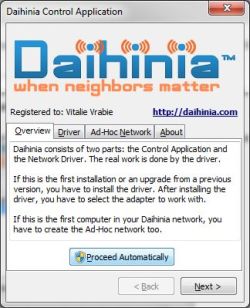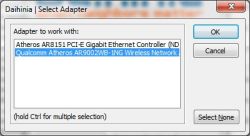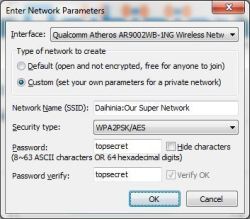Her gün sizlere, piyasa değeri onlarca dolar olan bir programı tamamen ücretsiz olarak sunuyoruz!

Giveaway of the day — Daihinia 1.7.9
Daihinia 1.7.9 giveaway olarak 7 Ekim 2013 tarihinde sunulmuştu
Daihinia WIFI için bir araçtır. Basit Ad-Hoc ağını Multi-hop Ad-Hoc ağına dönüştürür. Multi-hop Ad-Hoc ağları bilinen Infrastructure Mod!dan daha yüksek seviyede esneklik sağlamaktadır: Infrastructure Mod'da tüm bilgisayarlar Dağıtım Noktası'nın sınırları içinde olmak zorundadır. Fakat Multi-hop Ad-Hoc ağlar her bir bilgisayar diğerinin snırlarıyla işlev görebilir ve böylece sıçrama noktaları artmış olur.
Temelde, Daihinia WiFi için Ad-Hoc (IBSS) ağlarda Mesh ağ katmanı sağlamaktadır. Bu da Ağ yapısını dolaylı olarak kullanıcılar oluşturabilir anlamına gelmektedir. Kullanıcı kendi bilgisayarını kullanırken başkaları için bir ağ oluşturmaktadır.
Daihinia bu işi yaparken Windows sistemi için tasarlanmış ve tüm programlar için şeffaf, orta derece bir ağ sürücüsü kullanır..
Ticari kullanıma izin verilmektedir.
Sistem Gereksinimleri:
Windows XP SP3, Vista SP2, 2008 SP2, W7 SP1 (x32/x64)
Yayıncı:
DaihiniaWeb sayfası:
http://daihinia.com/Dosya boyutu:
7.78 MB
Fiyat:
$10






Daihinia 1.7.9 üzerine yorumlar
Please add a comment explaining the reason behind your vote.
LOL.... 63% THUMBS UP in a blink of an eye without having any idea what this tool actually does....this absolutely outclasses Aieesoft's dirty tricks for good!!
This is definitely a funny forum....LOL!
To understand what this software actually does I think people need a degree in IT science + a CISCO certification in networking...LOL!
Key terms ==> Multi-hop Ad-Hoc networks + Mesh Network funcionality
http://users.ece.utexas.edu/~rheath/research/multihop
http://en.wikipedia.org/wiki/Mesh_networking
When you connect to an ACCESS POINT (Public or Private), your machine communicates only with that Access Point, even when you send data (for instance an email) to another PC in the same WiFi network: in this case data travels to the Access Point first, which then send it in the air to the target machine in the network. To make sure that everything goes smoothly all participants in the network must be in the same range of the Access Point, but if the Access Point suddenly stops working the whole network fails as a result of that.
On the other hand, there is a so called "Ad-Hoc Mode" (also called IBSS), when all PCs into a network act as a sort of PEERS with equal rights, thus sending data directly to each other without needing to communicate to the Access Point first.
So what this tool does is to add the mesh functionality directly to any networked computers, turning a simple Ad-Hoc network into a Multi-hop Ad-Hoc network, by relaying packets from one PC to another one by using a computer in the middle (for nstance when two computers are out of range for each other): this way the communication between several PCs into a wifi network will always work, even if computers are NOT in the range of the Access Point.
In other words with this GAOTD users will no longer need any Access Points to build their network, since this tool is based on WiFi's Ad-Hoc mode of operation (obviously you need a WiFi adapter capable of Ad-Hoc mode to make it work).
So overall this GAOTD could actually be a very handy tool for those who use several LAPTOPS in home and small office networks, and are eager to use them as a sort of chain or path to the central PC (Server) designed to share its wired web conection to the wireless mesh network.
BEST FREEWARE ALTERNATIVES??
Dudes...don't ask me too much...be happy with my explanation!!
You could do one thing though, namely turn your laptop into a sort of hotspot access point: why not do that for FREE??
http://www.mypublicwifi.com/publicwifi/en/index.html
http://www.connectify.me/hotspot
http://www.wifihotspotcreator.com
http://sourceforge.net/projects/movirtualrouter
Enjoy!!
Save | Cancel
benny - Can't see what looks "convoluted" to you. I know someone will want to smack me for grossly oversimplifying but basically this allows each client of the WiFi net to rebroadcast. Your machine doesn't have to pick up the signal from the router, only from the nearest machine that's connected.
Save | Cancel
For #1 Let us say your WiFi router has a maximum range of 50 meters any thing on the network that is more than 50 meters away from the router will not be able to send or receive. So far understandable what this software will do is use for example a PC on the network that is only 25 meters away from the router and use it to extend another 50 meters from the PC (in theory)so now you "boosted" to 75 meters. I hope this helps.
Save | Cancel
Can you tell us again what this does, without all the technical bumf. That has to be one of the most convoluted descriptions, without giving anything away, I've ever seen
Save | Cancel
...Getting back to TODAY's offering:
Actually it's more than just extending the range of your router. A router is used to create an infrastructure network - i.e. one base to which all computers connect. This product is used to create a special ad-hoc network i.e. a computer-to-computer network (without a router).
Now normally, if you have such a network using computers A, B, and C, then all of these computers will need to be within range of each other: A and B must be able to communicate directly, similarly B and C, also A and C.
With this product, as long as A can communicate with B and B with C, then A and C do not need to be in range of each other: B will relay the signal from A to C. Similarly, a computer D that is also not in A's range or in B's range will be able to communicate with all the computers as long as it can reach computer C. The signal can "multi-hop" through the system.
Safety issues are basically the same as other wireless networking systems (encrypted signals - which can of course be tapped into). Just remember that this system will extend the physical range of the network and technically anyone tapping into a computer way out on the periphery could have access to the whole network.
I haven't yet tested this fully, but certainly any computer expected to relay signals would need to be running the software. I don't know if a peripheral computer that can communicate with a relaying computer and still "see" the whole network using only standard Windows components.
Hope this helps.
Save | Cancel